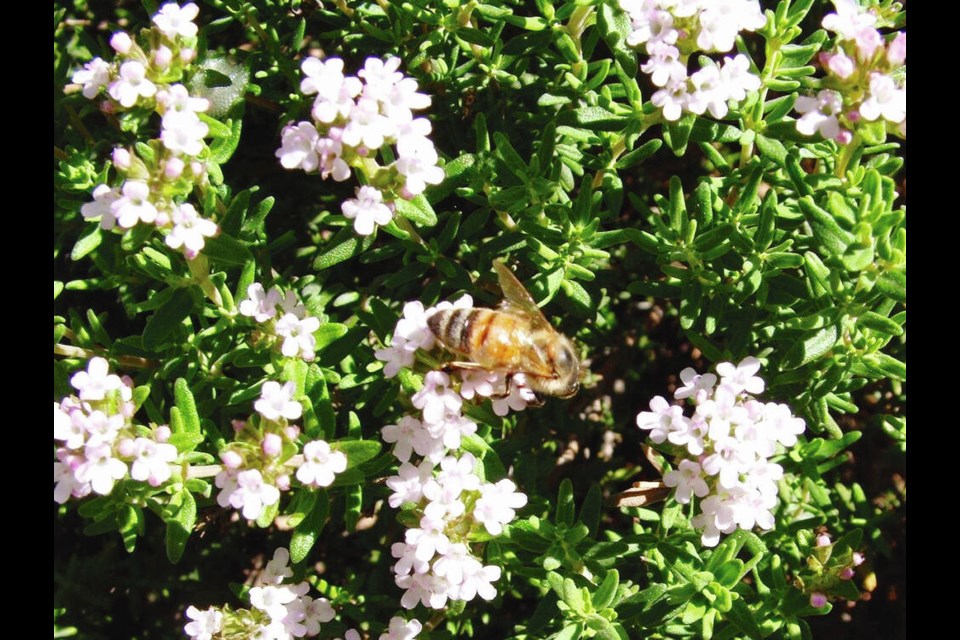Dear Helen: Have you been hearing any reports about bees this spring? I’ve watched for their activity in my garden and have been alarmed at how few bees I’ve observed.
G.M.
From my mail and speaking with other gardeners, including a friend whose business is helping out in home gardens, there has been a noticeable lack of bees.
Gordon, who gardens in Campbell River, wrote last month: “Warm May weather brought out pollinating insects in our garden. Then, just before mid-May, we noticed many dead bees. By May 15, the normally humming raspberry and cascade berry plants were growing silent. By late May, there were no pollinating insects to be seen.”
In my garden, plants that are normally full of bees, like carpets of bigroot geranium, kale and rhododendrons in bloom, have been visited by very few bees. I felt far less unease this year at dismantling the kale plants because, at best, I observed just one or two bees at a time in the six plants in full bloom.
Exceptions to the bee-lessness were the borage plants and the raspberries. Plenty of bee activity there. Over decades, borage has sown itself throughout the garden. I always keep a selection of the “volunteer” plants because I know they are a powerful bee attractant and food source.
According to a Times 91Ô´´ article in late April, the cold weather in March and most of April kept bees from becoming active and foraging for food. The delay might have contributed to the deaths that Gordon observed.
There are many other causes that are contributing to a decline in bee and other beneficial insect populations: Pesticide use, monoculture farming, drought, habitat loss, lack of food, air pollution, parasites, predators, climate change.
Growing as wide an assortment of flowering plants as possible in our gardens can help to support pollinating and other beneficial insects. The best are old-fashioned, simple flowers including single-flowered daisy-type blooms.
Some of the most effective nurturing plants for pollinators are sweet alyssum, calendula, candytuft, cilantro, parsley, dill, kale, the many kinds of thyme, lavender and rosemary.
Especially in these times of drought, providing a water source for beneficial insects is important. Use any shallow container, such as a plant tray or shallow bird bath, with rocks or gravel in it to provide safe perches for small insects as they access the water. Having a water source has been shown to help increase populations of beneficial insects.
Dear Helen: A friend has asked me to prune her overgrown lilac. Can you describe the best way to do this? I don’t want to ruin her shrub.
L.D.
When an old lilac has become overgrown and woody, probably the most reasonable way to rejuvenate it is to cut out, as close to ground level as possible, a third of the old wood each spring, Doing this over three years will gradually renew the plant while retaining some spring flowers.
Dear Helen: I’ve noticed the occasional mention of corn salad in your columns. It sounds as though it could be a useful addition to the salad greens I grow. Is seed easily available? When is the best time to plant?
S.T.
Almost all seed catalogues list corn salad. It might not be so easy to find it on seed racks, though outlets with a large selection of West Coast Seeds should have it. There are several varieties. West Coast currently lists Granon, a variety yielding “robust” little plants.
Corn salad is a hardy, cool-season green vegetable that thrives in cool, moist soils. It can be sown outdoors in very early spring or in August. It is not a speedy grower and spring sowings produce plants that are vulnerable to deterioration if there’s an early heat wave. That happened to my plants this spring.
More sure is a late summer sowing, for plants to produce through the fall, winter, and the following early spring. In fully sunny, open gardens that produce the fastest possible growth, a late August seeding works. In my partly shaded vegetable garden, I need to seed earlier, between the beginning and the middle of August.
Salt Spring Seeds lists a corn salad called Medallion on its website. I’ve always found their deliveries to be very rapid.



